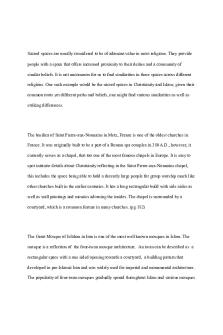Sacred Site Investigation-Cahokia & Chaco PDF

| Title | Sacred Site Investigation-Cahokia & Chaco |
|---|---|
| Course | Archaeoastronomy |
| Institution | St. Cloud State University |
| Pages | 3 |
| File Size | 70.7 KB |
| File Type | |
| Total Downloads | 59 |
| Total Views | 132 |
Summary
Solved Assignment...
Description
What is interesting about these sites? Cahokia Cahokia is more than just an archaeological site. It is a linchpin in the archaeology of eastern North America, tying together the Southeast with the Great Lakes and the Great Plains. Cahokia is one of UNESCO's World Heritage sites, was also the earliest of its kind in North America, making its effects on other cultural complexes of the time both apparent and, arguably, profound. Research designed to explore the Grand Plaza at the Cahokia Mounds site, the largest Mississippian-period mound center in the eastern United States, documents that plazas may yield significant information regarding Mississippian manipulation of the landscape and the initial growth of mound centers. Probing and excavation within the Grand Plaza revealed that buried ridge swale topography, identified through an electromagnetic conductivity survey, was stripped and then filled by the Cahokians. These excavations provide a unique window into previously unknown aspects of the construction and use history of this singular monumental space. the plaza appears to have been more spacious than the most generous previous estimate. A distinctive aspect of the Grand Plaza is the relatively level surface that contrasts with other sections of the Cahokia environs. These surrounding areas bear traces of the shifting Mississippi River in the form of ridge-swale topography. Two alternatives might explain the present Grand Plaza's level surface: that the area, with preexisting ridge-swale features, was buried by overbank deposition from successive flooding events, or the plaza was modified to form a fairly level surface by the prehistoric Cahokians in the creation of the central precinct.
Monks Mound is the largest and most dominant feature of the Cahokia site, the largest prehistoric Indian site north of Mexico. The great mound is also the largest earthen structure in North America. The edifice is undeniably impressive as monumental architecture. Monks Mound is a premier example of monumental architecture occupying the center of Cahokia, the largest prehistoric Indian site north of Mexico. A massive slump on the so-called "second terrace" of the mound prompted geoarchaeological testing resulting in new data concerning the age and function of this enigmatic structure Chaco 10 mile stretch of Chaco Canyon, in the heart of the San Juan Basin, there are remains of what was a thriving community built almost 1,000 years ago by the Anasazi, ancestors of today's Pueblos. The community once bustled with activity: irrigation systems were built; fields were leveled and a system of roads was laid out in and around Chaco. Now there are only the remains of several hundred stone wall buildings. Among them there are the ruins of nine multistory dwellings known as the Great Houses of Chaco. Of the nine Great Houses the most famous and most thoroughly studied is Pueblo Bonito. It has a distinctive D shape and occupies almost three acres of ground. When it was finally completed in the 12th century, it contained more than 650 rooms and was the largest of the Great Houses. Pueblo Bonito and the other Great Houses in the canyon are constructed from blocks of sandstone, carefully coursed in beautiful patterns. The sandstone blocks fit together tightly, forming walls that are as much as a meter thick at ground level and decrease slightly with each successive story. The walls are far stronger, some 45,000 kilograms of sandstone cut by hand from the surrounding cliffs, for example, were needed to build a single small room in one of the
Great Houses; as many as 50 million pieces of sandstone may have been cut to build Chetro Kelt alone....
Similar Free PDFs

Harvardsys - site
- 6 Pages

ICA of Sacred Spaces
- 4 Pages

SITE ANALYSIS
- 36 Pages

Site Synthesis
- 1 Pages

Plan du site - Plan du site
- 2 Pages

Indigenous sacred ways notes
- 3 Pages

Sources for sacred space
- 2 Pages

Ley de catastro Chaco-4851
- 12 Pages

GSU Rec Site Evaluation
- 4 Pages

Engineering Site Observation Report
- 11 Pages

SIte Investigation (SV-a)
- 28 Pages

Lecture 5 - Site Appraisal
- 3 Pages
Popular Institutions
- Tinajero National High School - Annex
- Politeknik Caltex Riau
- Yokohama City University
- SGT University
- University of Al-Qadisiyah
- Divine Word College of Vigan
- Techniek College Rotterdam
- Universidade de Santiago
- Universiti Teknologi MARA Cawangan Johor Kampus Pasir Gudang
- Poltekkes Kemenkes Yogyakarta
- Baguio City National High School
- Colegio san marcos
- preparatoria uno
- Centro de Bachillerato Tecnológico Industrial y de Servicios No. 107
- Dalian Maritime University
- Quang Trung Secondary School
- Colegio Tecnológico en Informática
- Corporación Regional de Educación Superior
- Grupo CEDVA
- Dar Al Uloom University
- Centro de Estudios Preuniversitarios de la Universidad Nacional de Ingeniería
- 上智大学
- Aakash International School, Nuna Majara
- San Felipe Neri Catholic School
- Kang Chiao International School - New Taipei City
- Misamis Occidental National High School
- Institución Educativa Escuela Normal Juan Ladrilleros
- Kolehiyo ng Pantukan
- Batanes State College
- Instituto Continental
- Sekolah Menengah Kejuruan Kesehatan Kaltara (Tarakan)
- Colegio de La Inmaculada Concepcion - Cebu



